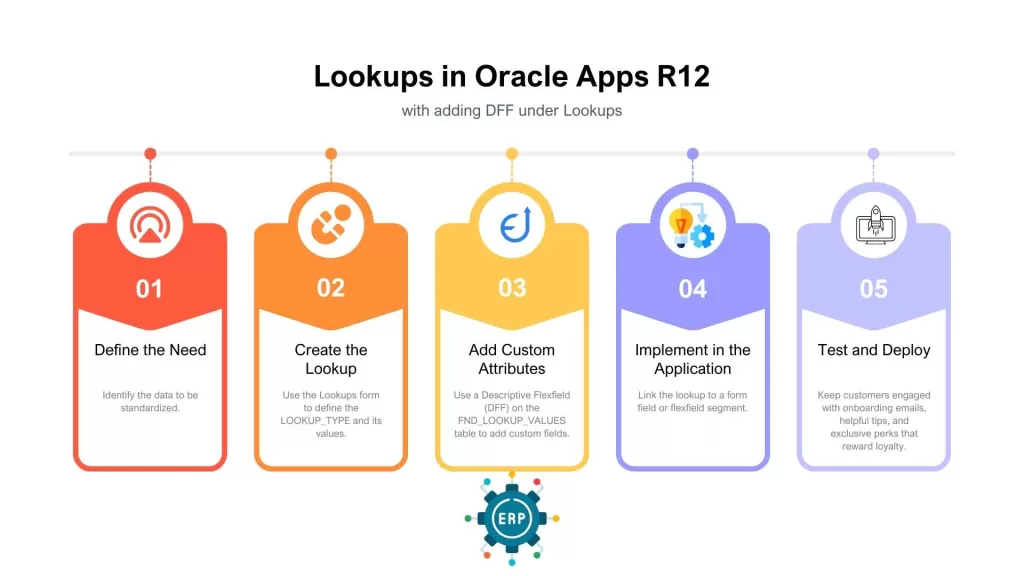
Lookups in Oracle Apps R12
In Oracle Apps R12, the Lookups is one of the fundamental configuration objects. It is the predefined list of values (LOVs) that are displayed to users while transacting or configuring the application. For example, while creating a customer, you might be requested to enter a Customer Category from the predefined list like Retail, Wholesale, Distributor.
Lookups enable consistency, validation, and controlled variability across Oracle Applications. Functional and technical consultants usually come across them in setups, form personalizations, or custom extensions.
Table of Contents
Types of lookups in Oracle Apps R12
Step-by-step Process for Lookup Creation
What Are Lookups in Oracle Apps R12?
An Oracle Apps lookups is a static list of codes and code meanings that are used to validate user inputs and to standardize system-wide values. Oracle lookups are like mapping tables with lookup types will have some specific code with their meaning, description and effective dates.
Each lookups has below fields:
- Lookup Type: Category name (e.g., CUSTOMER_CATEGORY)
- Lookup Code: Internal code (e.g., RETAIL)
- Meaning: The clear description displayed in the LOV (e.g., Retail Customer)
- Description: Optional notes or details
- Enabled Flag: To enable/disable the code
- Effective Dates: To control the validity period
Types of Lookups in Oracle Apps R12
Oracle specifies various lookup categories. Below are the types of lookups in Oracle Apps R12.
System Lookups
- Delivered by Oracle
- Cannot be edited or deleted
- Example: YES_NO lookup (values: YES, NO)
Extensible Seeded Lookups
- Delivered by Oracle but can be extended
- You can add codes but cannot delete Oracle’s defaults
- Example: CUSTOMER_CATEGORY
User Lookups (Custom Lookups)
- Created by users for specific business needs
- Fully managed by the functional consultant or system administrator
- Example: CAMERA_PRODUCT_TYPE with values DSLR, Mirrorless, Printer
Lookups vs. Value Sets
While both lookups and value sets are used to provide lists of values, they have distinct differences.
| Feature | Lookups | Value Sets |
|---|---|---|
| Data Source | Static, predefined lists of values stored in FND_LOOKUP_VALUES. | Can be static (using lookups), or dynamic (using SQL queries on tables). |
| Flexibility | Less flexible. Provides a simple, static list. | More flexible. Can be table-validated, independent, or dependent on other values. |
| Use Case | Ideal for simple, non-changing lists like statuses, genders, or yes/no flags. | Used for more complex lists, such as a list of customers, suppliers, or a dynamically populated list from a database table. |
| Validation | One-to-one mapping between code and meaning. | Can use a variety of validation rules, including format validation and SQL validation. |
Where Are Lookups Used?
Lookups appear across Oracle Apps modules. Below are some of the Oracle Apps Lookups used accross Oracle EBS.
- Order Management: Order types, reasons, line statuses
- Receivables: Customer categories, statement cycles
- Payables: Invoice types, payment methods
- HRMS: Gender, marital status, employee types
- Custom Extensions: LOVs in custom forms and reports
Step-by-Step: How to Create Lookups in Oracle Apps R12
Step 1: Responsibility Navigation
- Login to Oracle Apps Application
- Navigate: Application Devceloper → Application → Lookups → Common
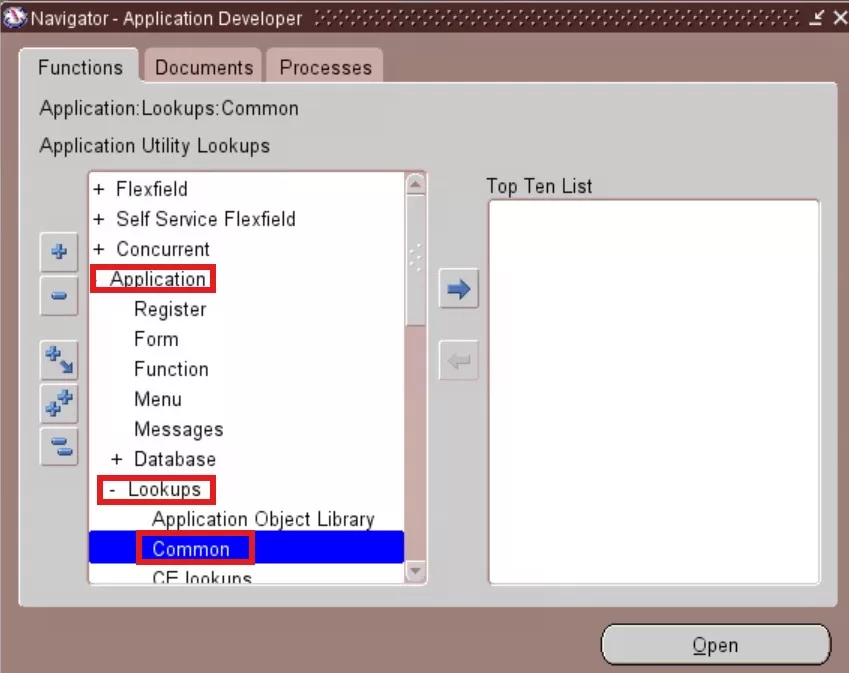
Step 2: Enter Lookup Type
- Enter a unique Lookup Type (e.g., PRODUCT_CATEGORY)
- Provide a Meaning (e.g., Product Category)
- Choose an Application (where it will be used)
- Description (User Description)
- Access Level (User)

Step3: Define Lookup Codes
For each code, provide:
- Code (e.g., CAMERA, PRINTER)
- Meaning (e.g., Camera, Printer)
- Description (optional)
- Tag (Keeps any extra value for identification)
- Enabled Flag
- Start/End Date
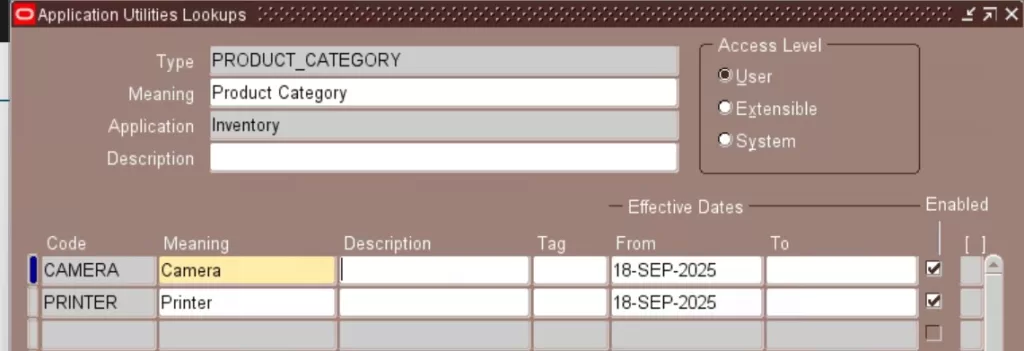
Step 4: Save
Your lookup is now available for use in forms, personalization, or extensions.
Example: Lookup for Product Types
Suppose you run a camera and printer business and want to classify items:
- Lookup Type: PRODUCT_CATEGORY
- Lookup Codes & Meanings:
- CAMERA → Camera
- PRINTER → Printer
- ACCESSORY → Accessory
When creating inventory items, this lookup ensures consistent categorization.
Steps to add a DFF to lookups
The FND_LOOKUP_VALUES table has a set of ATTRIBUTE columns (e.g., attribute1 to attribute15) and a context column. Oracle has pre-configured a DFF on this table. By setting up this DFF, you can map the attribute columns to custom segments and use the context column to make the DFF segments context-sensitive based on the lookup type.
1. Define the DFF for FND_LOOKUP_VALUES
- Navigate to the DFF Register form using Application Developer responsibility and go to Flexfield -> Descriptive ->Register.
- Query the DFF: Query for “Table Name” FND_LOOKUP_VALUES table and get the dff title “Common Lookups”

- Navigate to the DFF Segments(Flexfield -> Descriptive -> Segments) and query for DFF title “Common Lookups”
- Unfreeze the Flexfield: Ensure the “Freeze Flexfield Definition” checkbox is unchecked to make changes.
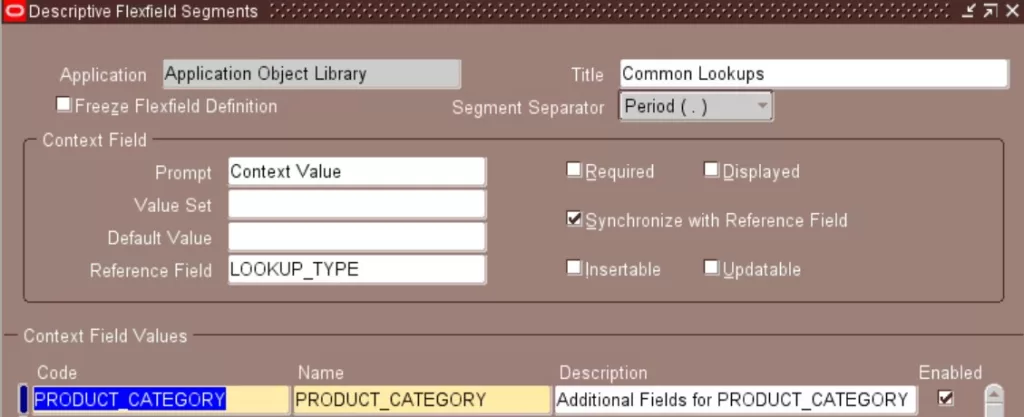
- Add Contexts: Create a new context for each lookup type. The context code must be the exact name of the lookup type (e.g., PRODUCT_CATEGORY).
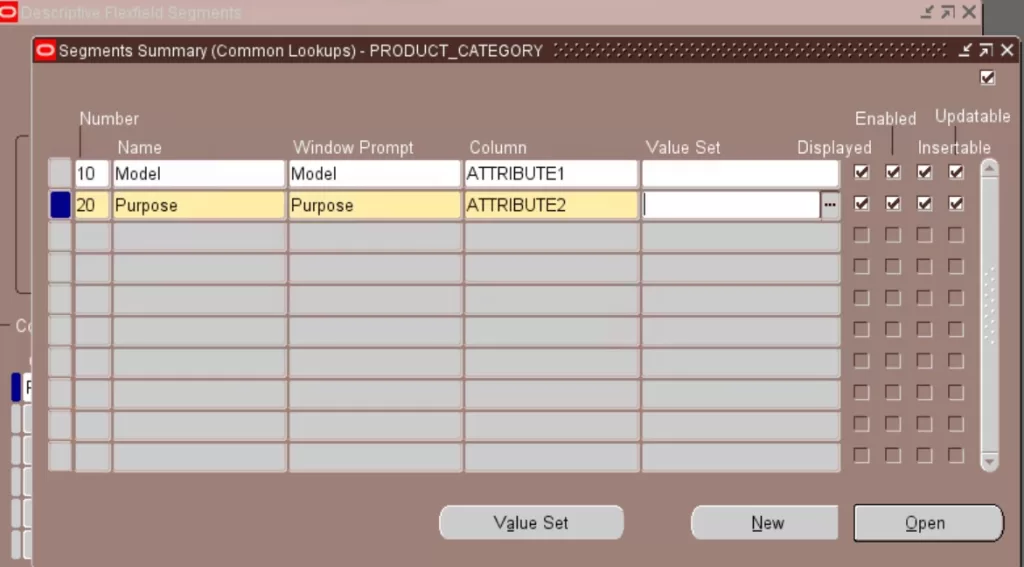
- Add Segments: Under the appropriate context (either the new one you created or the “Global Data Elements” for a global DFF), add your new segments.
- Give each segment a Name and a Window Prompt
- Map the segment to an available ATTRIBUTE column (e.g., ATTRIBUTE1, ATTRIBUTE2).
- You can attach a Value Set to validate the data entered by the user.
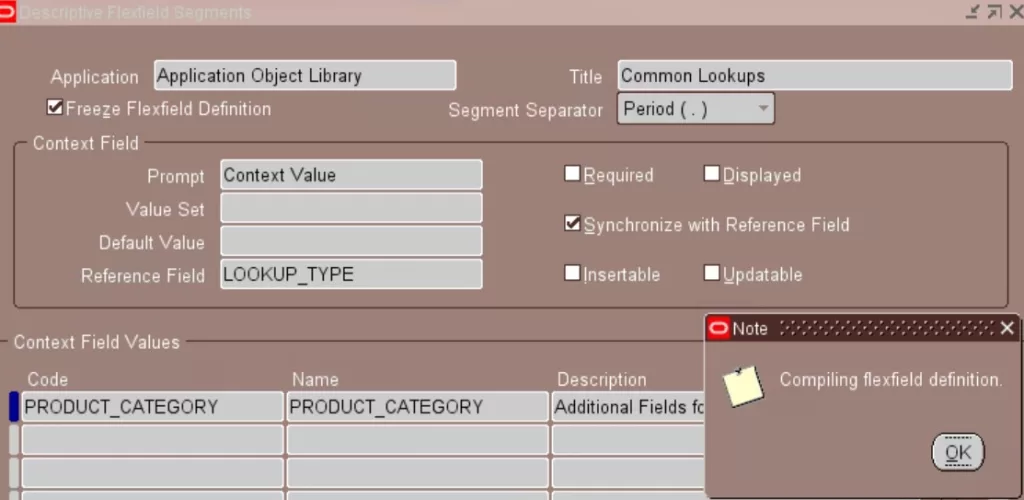
- Freeze and Compile: Once you defined the segments, check the “Freeze Flexfield Definition” box and click the Compile button. This registers your changes in the database and generates the necessary form files.
2. Populate the DFF Segments for your Lookups
After you compile the DFF, the new fields will be available on the Lookups form.
- Navigate to the Lookups form: Go to Application Devceloper → Application → Lookups → Common.
- Query your Lookup Type: Find the lookup type you want to add DFF values to (e.g., PRODUCT_CATEGORY).
- Enter DFF Values: For each lookup code, you can now enter values in the new DFF segments you created. You need to press the “[ ]” in each lookup code and DFF segments will be opened
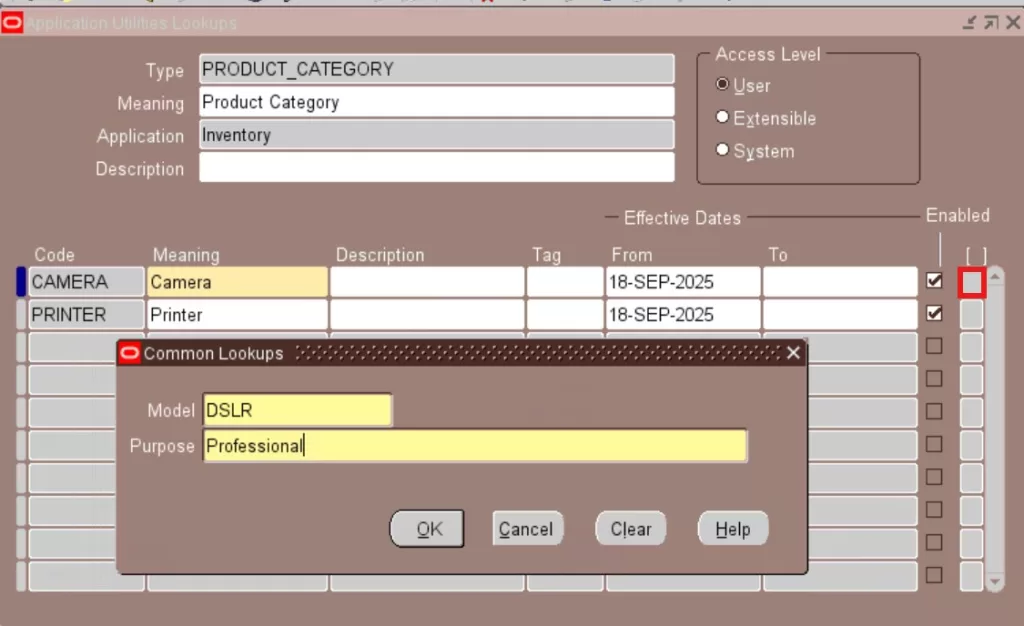
- Save your work. You store the new DFF values in the ATTRIBUTE columns of the FND_LOOKUP_VALUES table.
SQL Queries for Lookups in Oracle Apps R12
In this ssection you can learn how to use SQL to get lookups, lookups values.
1. To View All Lookups Types
SELECT lookup_type, meaning, description, application_id
FROM fnd_lookup_types_vl
ORDER BY lookup_type2. To View Lookups Codes for a Specific Type in Oracle Apps
SELECT lookup_type, lookup_code, meaning, description, enabled_flag, start_date_active, end_date_active
FROM fnd_lookup_values_vl
WHERE lookup_type = 'PRODUCT_CATEGORY'
ORDER BY lookup_code;

3. To Search a Specific Lookups Code in Oracle Apps
SELECT lookup_code, meaning, description
FROM fnd_lookup_values_vl
WHERE lookup_type = 'CUSTOMER_CATEGORY'
AND lookup_code = 'RETAIL';
Best Practices for Managing Lookups
✅ Use consistent naming conventions
✅ Do not modify system lookups—extend them
✅ Apply effective dates for validity control
✅ Document custom lookups for support and audit purposes
✅ Test changes before deploying to production
Real-World Use Case
A sports academy management system built on Oracle Apps R12 tracks Membership Types:
- Lookup Type: MEMBERSHIP_TYPE
- Lookup Codes: BASIC, PREMIUM, VIP
- Meanings: Basic Membership, Premium Membership, VIP Membership
Whenever a new member is registered, the user selects a membership type. This ensures consistency in reporting, billing, and member management.
Conclusion
Lookups in Oracle Apps R12 are simple yet powerful tools for ensuring data accuracy, flexibility, and standardization. Whether you’re a functional consultant or a technical developer, mastering lookups is key to effective Oracle EBS management.
Properly managing lookups helps reduce errors, enforce business rules, and improve data quality.
👉 Next Step: Learn about Value Sets in Oracle EBS, which build on lookups with advanced validation and dynamic list capabilities.




Pingback: Mastering Value Sets in Oracle Apps R12